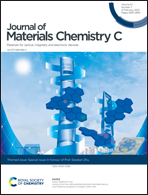A cationic conjugated polymer with high 808 nm NIR-triggered photothermal conversion for antibacterial treatment†
Abstract
A light-triggered treatment strategy has been considered as a powerful therapeutic modality for sterilization due to its attractive properties including noninvasiveness, negligible drug resistance and minimized adverse side effects. Herein, a cationic water-soluble conjugated polymer PDTPBT based on a donor–acceptor (D–A) structure is designed and synthesized for photothermal antibacterial therapy under near-infrared light irradiation. The electron-rich dithieno-pyrrole and electron-deficient benzothiadiazole served as the electron donor and acceptor, respectively. Also, quaternary ammonium groups are modified on the side chain to enhance the water solubility of PDTPBT, promoting the effective combination of PDTPBT with bacteria. PDTPBT demonstrates a strong absorption in the near-infrared region, excellent photostability and a high photothermal conversion efficiency of up to 71.1%. High bacterial mortality rates are obtained upon 808 nm laser irradiation. Consequently, the new cationic conjugated polymer PDTPBT with excellent photothermal performance exhibited effective antibacterial ability, serving as a promising agent for light-triggered treatment.

- This article is part of the themed collection: Special issue in honour of Daoben Zhu


 Please wait while we load your content...
Please wait while we load your content...